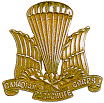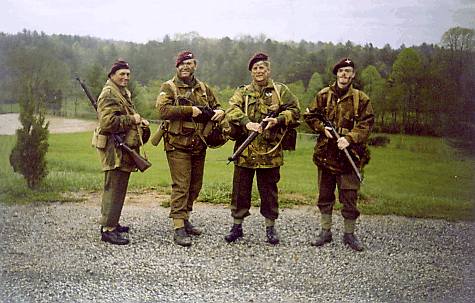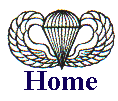
1st Canadian Parachute Battalion,
6th Airborne Division

History
In 1942 there was a possibility the Germans could attempt to land a small force in Canada to reduce Canada's effort in the Second World War. It was felt that a highly mobile unit could quickly react to such an event, if required. This unit would need to be mobile, versatile, agressive, and relatively self-sustaining in order to be effective if such an incident ocurred. It was suggested the use of an airborne force could meet this requirement. Mr. Ralston, the Minister of Defence, signed the order for the formation of One Canadian Parachute Battalion (1 Can Para) on 01 July 1942 to protect Canada in the event that enemy troops were landed. The operational role was later changed to allow the unit to serve over seas in the Second World War.
The battalion would consist of the following:
1. Battalion Headquarters
2. Company Headquarters
3. Alpha, Bravo, Charlie Companies
The battalion would have a total strength of 26 officers and 590 other ranks. At this period in the war, the United States and England had already established airborne forces and the training schools required to teach parachuting and tatics. It was decided that an initial drawing for 1 Can Para would be divided into two groups. The first group would be sent to the United States (Fort Benning, Georgia) for parachute training while the second group would travel to England (Ringway) for parachute training. This would allow for the comparison of parachuting techniques of both the US and England and allow the Canadians to determine the best methods for the development of the a Canadian Parachute Training wing.
The US training was comprised of an intensive four week program. The training regime consisted of the following:
Week One - Physical Training
Week Two - Basic Ground and Low Level Tower Training
Week Three - High Tower Training (250 Foot Para Descent)
Week Four - Parachute Qualification (Must complete five parachute descents)
During the unit's training at Fort Benning, some members were subsequently recruited to form a special operational group to be known as the First Special Service Force. Parachute training (at Fort Benning) was completed in the spring of 1943 and saw the return of 1 Can Para to Canada. The Battalion completed its first unit jump on 4 May 1943. June 1943 saw the Battalion preparing for its' move to Ringway in Enlgand.
1 Can Para arrived in Enlgand in July 1943. Over the next year the Battalion began training for airborne operations. Training included section, platoon, company, and battalion operations with special emphasis placed on weapons and physical training. It was decided to model the unit off British Airborne system, which was implemented into the battalion training. Training later included combined operations with the British Airborne units and involved tactics, standard operating procedures (SOPs) including brigade and divisional operations.
Operation Overlord, the invasion of Normandy, was to be 1 Can Para's first action and operational parachute jump. 1 Can Para would be part of 3rd Brigade of the British 6th Airborne Division.
Battalion orders for the D-Day invasion were:
"The 1st Canadian Parachute
Battalion was to land one hour in advance of the rest of the brigade in order to secure
the dropping zone (DZ) and capture the enemy headquarters known to be located on the DZ.
Thereafter there are to destroy road bridges over the River Dives and its tributaries at
Varaville, then neutralize the strong points on the cross roads."
"In addition the Canadians were to protect the left
(southern) flank of the 9th Battalion during that battalion's attack on the Meriville
Battery, and then seize and hold a position astride the Le Mesnil cross roads, a vital
strategic position at the centre of the ridge."
The commanding officer of 1 Can Para, Lt. Col. GFP Bradbrooke issued the following tasks to his company commanders:
C Company (Major HM Macleod) was to secure the DZ, destroy the enemy headquarters (HQ), secure the SE corner of the DZ, destroy the radio station at Varaville, and blow the bridge over the Divette stream in Varaville. C Coy would then join the battalion at the Le Mesnil cross roads.
A Company (Major D Wilkins) would protect the left flank of 9th Battalion during their attack on the Merville Battery and then cover 9th Battalion's advance to the Leplein feature. They would seize and hold the Le Mesnil cross roads.
B Company (Major C Fuller) was to destroy the bridge over the River Dives within two hours of landing and deny the area to the enemy until ordered to withdraw to Le Mesnil cross roads.
It should be noted that each paratrooper carried almost 50% more than the acceptable load tables for the invasion aircraft. Most of this additional load was extra ammunition. 1 Can Para assembled and boarded their aircraft in the evening hours of 5 June 1944. C Company departed at 2230 hours as part of the Pathfinder Group for the British 6th Airborne Division main force. The D-Day invasion had begun.
The battle for the DZ and surrounding areas was tough and sometimes quite intense, but it was later determined that the German Army did not recognize that paratroops had been utilized until it was to late. By mid-day, 06 June 1944, 1 Canadian Parachute Battalion had completed all tasks and seized their objectives. From this time until 06 September 1944, the Battalion was employed as an infantry unit on defensive and offensive operations. On the 6th September 1944, the Battalion returned to England (Carter Barracks) to recuperate, reorganize, brought up to strength, and prepare for their next mission.
On the 2nd January 1945, the Battalion arrived at the front to aid in pushing the Axis forces back, out of Belgium and the Ardennes. This would be the Battle for the Bulge.
1 Can Para was positioned to complete patrolling (both day and night) and defend against any enemy attempts to infiltrate into the area. The Battalion's push forward took them through the towns of Aye, Marche, Roy, and Bande. The taking of Bande marked the end of the fight for the Bulge and the Battalion's participation in the operation.
The Battalion's next major offensive operation was in the Netherlands. Patrolling again was the major activity from 22nd January 1945 to approximately 21st February 1945.
Operation Plunder was the code name given for the offensive operation which would oversee the invasion of Germany and bring about the end of the Second World War. Airborne forces would be used to seize areas of tactical importance which could be defended until the main Allied Forces could arrive to relieve the paratroopers. This massive airborne/glider assault was codename "Operation Varsity."
The 17th Airborne Division (United States) and the 6th Airborne Division (British) objectives would be the Wesel and the Rhine River, to be completed as a combined paratrooper and glider operation. Complicated enough, however, add to this a jump in broad daylight.
3rd Brigade (1 Can Para, 8th, 9th Battalions), 6th Airborne Division tasks would be the following:
1. To clear the DZ and establish a defensive
position on the north end of the Diersfordter Wald and along a road at the west end of the
DZ.
2. To seize the Schnappenburg feature astride the main road road running north
and south of this feature.
It was reported that Brigadier Hill stated during his briefing:
"Speed and initiative is the order of the day. Risks will be taken. The enemy will be attacked and destroyed wherever he is found. Gentlemen, the artillery and air support is fantastic. Beaten and demoralized, pounded by our artillery and bombers, what would you think gentlemen, if you saw a horde of ferocious, bloodthirsty paratroopers, bristling with weapons, cascading down from the skies? And you needn't think, just because you hear a few stray bullets flying about, that some miserable Hun is shooting at you. That is merely a form of egotism. But if by any chance you should happen to meet one of these Huns in person, you will treat him, gentlemen, with extreme disfavor. "
Brigadier Hill assigned the following tasks to 3rd Brigade:
1. 8th Battalion (British) would seize the northern
part of the Wald.
2. 9th Battalion (British) would seize the southern part of the Wald to
include the Schnappenburg Feature.
3. 1 Can Para Battalion would seize and hold the central area.
The central area consisted of the western edge of the woods, a main road running north from the Wesel to Emmerich, and a number of houses. It was believed this area was held by German Paratroopers. C Company would clear the northern part of the woods near the junction of the roads to Rees and Emmerich. Once this area was secure, A Company would advance through the position and seize the houses located near the DZ. B Company would clear the south western part of the woods and secure the Battalion's flank.
In preparation of the daylight drop all local airfields and suspected enemy positions were bombed repeatedly, with the DZ softened by artillery. At 0730 hrs, 24th March 1945, 1 Can Para enplaned from Chipping Ongar on 35 C-47s transport aircraft of the IX Troop Carrier Command, USAAF. Operation Varsity was about to begin.
As the Battalion exited the aircraft they came under heavy machine gun fire, due partly to the resistance 8th Battalion had encountered while attempting to secure the DZ. 1 Can Para's objectives were well defended, requiring tremendous effort in order to take and secure the area. Many men were lost during the descent, including the Battalion's Commanding Officer, Col. Nicklin. Paratroopers were scattered across and beyond the DZ, due to the viscousness the German defense (aircraft could not slow down sufficiently due to the risk of being shotdown), with some men landing on enemy positions.
Many members of 1 Can Para distinguished themselves during the initial assault including Corporal Topham winning the Victoria Cross. Corporal George Topham was to receive the Victoria Cross for his valiant effort in the rescue of many injured paratroopers.
By late afternoon, all the Battalion's objectives had been secured, with defensive positions constructed. An air drop resupply ensured all battalions were ready for any attempt to counter-attack, if it should come. The first unit to reach the Battalion was an advance recce unit from the 15th Scottish Division, followed by the arrival of infantry units of the 2nd Army on the 25th March 1945. This completed the Rhine Crossing and signalled the commencement of the invasion of Germany.

Minimum Equipment Requirements:
1. WWII British battledress and Denison Smock(with Canadian wings)
2. 1937 pattern web gear: waist belt, universal pouches, pair of braces, water
bottle and
carrier, bayonet frog and pair of gaiters
3. British ammunition boots
4. British Parachutist Steel helmet and maroon beret (with Canadian Wings)
5. No. 4 Mk 1/2 Lee Enfield .303 caliber rifle and No. 4 Bayonet and sheath.
Commander:
Paul Crawley (770) 509-2534
 |
 |